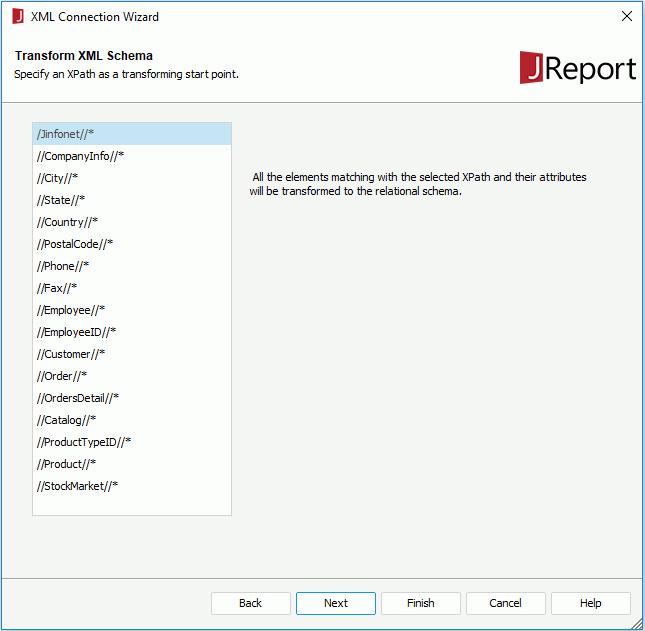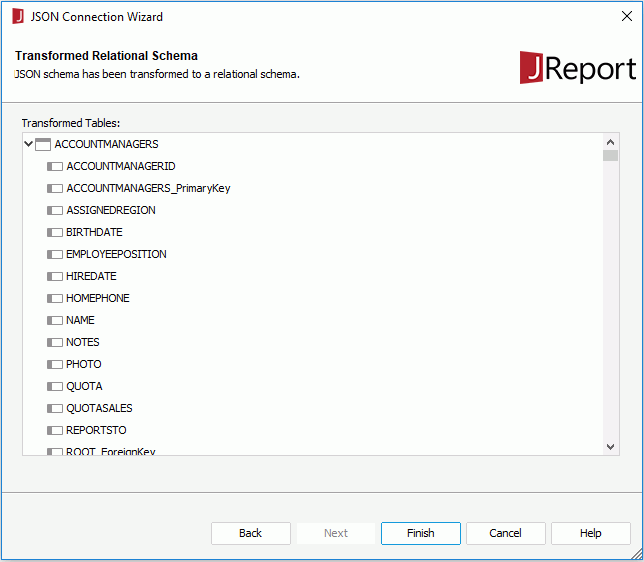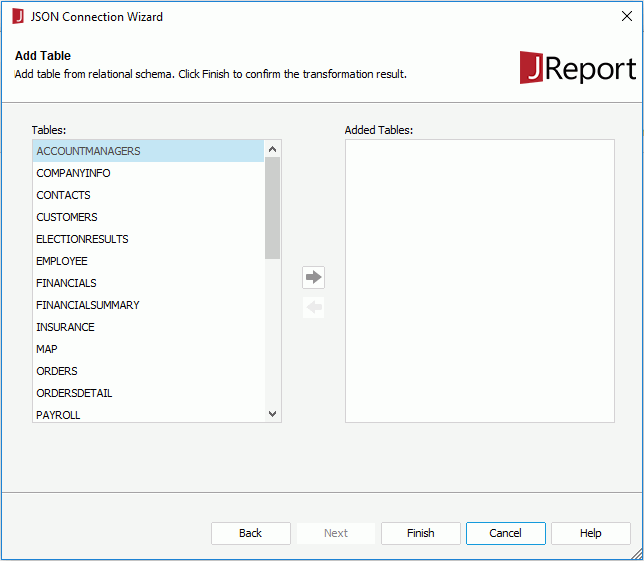JSON Connection Wizard Dialog
The JSON Connection Wizard appears when you select JSON and select OK in the New Data Source dialog, or in the Catalog Manager right-click a data source and select New JSON Connection from the shortcut menu or right-click an existing JSON connection and select Edit Connection from the shortcut menu. It helps you to import an XML schema and transform it to a relational schema for future use, and consists of the following screens:
Back
Goes back to the previous screen.
Next
Goes to the next screen.
Finish
Finishes confirming to transform a JSON schema to a relational schema.
Cancel
Does not retain changes and closes this wizard.
Help
Displays the help document about this feature.
Extract JSON Schema
Specifies the necessary information to extract JSON schema. See the screen.
Schema Source
Specifies the source to extract JSON schema: Extract Schema from Sample Data or Extract Schema from Instance Data. Options on the screen differ with the schema source.
- When Extract Schema from Sample Data is selected, the following options are available:
Sample Data
Specifies the sample file by selecting the Browse button or inputting the URI string directly in the text box. In the URI string, you can reference parameters and constant level formulas in the current catalog data source and the special field User Name in the format "@fieldname".
- RESTful
The button is activated when the specified URI string begins withhttp://orhttps://protocol. Selecting it opens the RESTful Data Source Options dialog, in which you can define the RESTful options for the sample data.
URI
Specifies to get instance data from URI.
- Instance
Specifies the JSON instance by selecting the Browse button or inputting the URI string directly in the text box. It should match with the JSON schema defined in the specified sample data file. In the URI string, you can reference parameters and constant level formulas in the current catalog data source and the special field User Name in the format "@fieldname".- RESTful
The button is activated when the specified URI string begins withhttp://orhttps://protocol. Selecting it opens the RESTful Data Source Options dialog, in which you can define the RESTful options for the instance data.
- RESTful
User Defined
Specifies to get instance data from user defined interface.
- Class Name
Specifies the full name (including package name) of the class by selecting the Browse button or inputting the class name directly in the text box. The class should be appended to the class path in the system environment. - The class implements
After filling in the Class Name field, the class name of the interface that the class implements will be displayed here. - Parameter
Specifies the parameter string for the user defined data interface. The parameter string must match the format defined in the class. In the parameter string, you can reference parameters and constant level formulas in the current catalog data source and the special field User Name in the format "@fieldname".
New Parameter
Opens the New Parameter dialog to create a parameter in the current catalog data source. You can then reference the parameter to dynamically specify a JSON instance or user defined interface that matches with the selected JSON schema at runtime.
- RESTful
- When Extract Schema from Instance Data is selected, the following options are available:
Instance
Specifies the JSON instance by selecting the Browse button or input the URI string directly in the text box. In the URI string, you can reference parameters and constant level formulas in the current catalog data source and the special field User Name in the format "@fieldname".
- RESTful
The button is activated when the specified URI string begins withhttp://orhttps://protocol. Selecting it opens the RESTful Data Source Options dialog, in which you can define the RESTful options for the instance data.
- RESTful
Refresh
Enabled only when you edit an existing JSON connection. Once you make some change in the wizard and select the Refresh button, the JSON schema information will be reloaded according to what you have changed.
Edit Format
Opens the Edit Format dialog to specify the value formats of the referenced parameters and formulas.
- Name
Displays names of the parameters and formulas. - Format
Specifies the value formats of the parameters and formulas. - OK
Accepts changes and closes the dialog. - Cancel
Does not retain changes and closes the dialog.
Modify Schema Properties
Specifies properties of the JSON schema. See the screen.
Schema
Lists the corresponding schema structure of the root.  stands for elements,
stands for elements,  stands for the attributes in the XML schema and
stands for the attributes in the XML schema and  stands for the references of elements.
stands for the references of elements.
Properties
Lists all the properties of the selected elements and attributes in the schema.
- Name
Displays names of properties of the selected elements or attributes. - Value
Specifies values of properties for the selected elements or attributes.
Transformed Relational Schema
This screen lists the transformed relational schema structure. It helps you to select Next to confirm the transformation results and go into the Add Table screen. See the screen.
Transformed Tables
Shows tables transformed from JSON schema.
Add Table
Adds tables that are transformed from the relational schema to the connection. This screen is not available when you edit an existing JSON connection. See the screen.
Tables
Lists the tables transformed from the JSON schema.
Added Tables
Lists the tables that you have added from the relational schema.

Adds the selected tables.

Removes the selected tables from the Added Tables box.
 Previous Topic
Previous Topic




